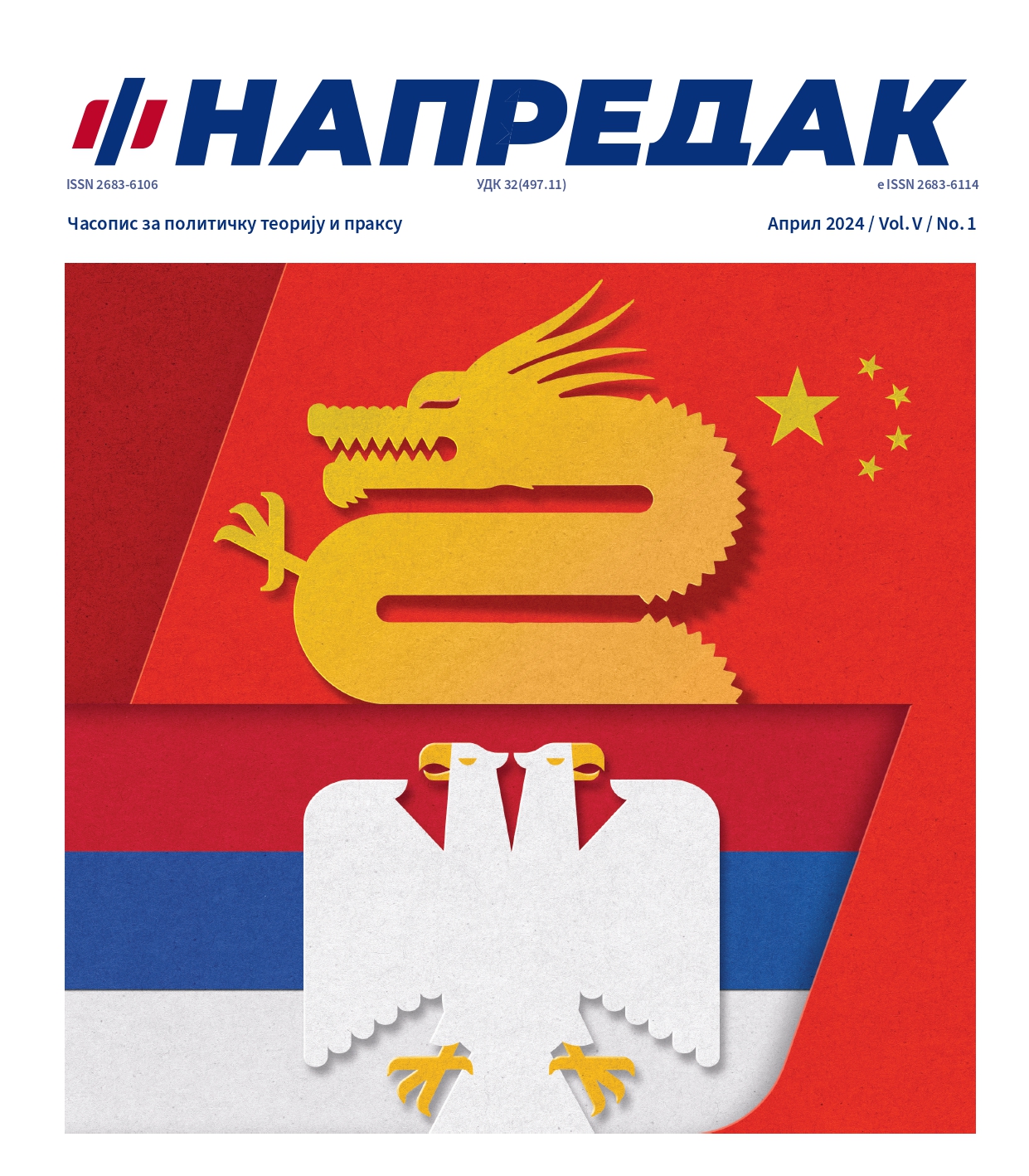Да ли Кина (стварно) посустаје?
(Амерички аргументи против даљег успона Кине)
Sažetak
Свесни чињенице да Кина представља државу чији успон указује на могућност развијања довољног нивоа способности да се угрози америчка светска хегемонија, тамошњи аутори све чешће развијају тезу да савремена Кина коначно – лагано али сигурно економски посустаје, што вероватно води њеном повратку у претходно – подређено стање на глобалној сцени. У раду је најпре представљен мотив због којег идентификовани аутори приступају таквим разматрањима, док су у наставку представљена четири идентификована скупа аргумената против даљег успона Кине америчких аутора (демографска кретања, економска стагнација, институционални проблеми и крах глобализације). Коначно, у трећем поглављу се кроз расправу о представљеним аргументима пружа одговор на питање да ли Кина заиста посустаје.
Reference
Acemoglu, D. & Robinson, J. (2014). Why Nations Fail. Beograd: CLIO. [In Serbian]
Beckley, M. and Brands, H. (2021). The End of China’s Rise: Beijing Is Running Out of Time to Remake the World. Foreign Affairs. Available at: https://www.foreignaffairs.com/articles/china/2021-10-01/end-chinas-rise
Brands H. & Beckley, M. (2021). China Is a Declining Power – and That’s the Problem. Foreign Policy. Available at: https://foreignpolicy.com/2021/09/24/china-great-power-united-states/
Brands H. & Beckley, M. (2022). Danger Zone: The Coming Conflict with China. New York: W. W. Norton & Company, Inc.
Brooks, S. G. & Wohlforth, W. C. (2023). The Myth of Multipolarity: American Power’s Staying Power. Foreign Affairs, CII (3), 76–91. Available at: https://www.foreignaffairs.com/united-states/china-multipolarity-myth
Chen, S. (2021, September, 30). China’s population could halve within the next 45 years, new study warns. South China Morning Post. Available at: https://www.scmp.com/news/china/science/article/3150699/chinas-population-could-halve-within-next-45-years-new-study
Cvetkovic, V. N. (2018). Uncertain Future and Limited Time. In: V. Cvetković (ed.) The New Silk Road: European Perspective (Security Challenges/risks within the Initiative 16 + 1) (21–48). Belgrade: Faculty of Security Studies
Cvetkovic, V. N. (2022). History Resurrected (Ideological Metamorphoses of the Global Order). Sociološki pregled, LVI (3), 832–872. DOI: 10.5937/socpreg56-40414
Eberstadt, N. and Vardery, A. (2021). China’s Shrinking Families: The Demographic Trend That Could Curtail Beijing’s Ambitions. Foreign Affairs. Available at: https://www.foreignaffairs.com/articles/china/2021-04-07/chinas-shrinking-families
French, H. (2024). The Reason China Can’t Stop Its Decline. Foreign Policy. Available at: https://foreignpolicy.com/2024/01/23/china-decline-economy-demographics-geopolitics-growth/
Fuxian, Y. (2023). The Chinese century is already over. The Japan Times. Available at: https://www.japantimes.co.jp/opinion/2023/03/10/commentary/world-commentary/china-population-decline/
Grieco, J., Ikenberry, J., Mastanduno, M. (2015). Introduction to International Relations. New York: Palgrave McMillan.
Huang, Y. (2023). The Rise and Fall of the EAST. New Haven and London: Yale University Press.
Iglesias, S. G., Matthes, J. (2023). Chinas Abhängigkeit vom Westen bei Importen und Technologien. Köln: Institut der deutschen Wirtschaft.
Itzkowitz Shifrinson, J. (2018). Rising Titans, Falling Giants: How Great Powers Exploit Power Shifts. Ithaca and London: Cornell University Press.
Kennedy, P. (1999). The Rise and Fall of the Great Powers. Podgorica–Beograd CID – Službeni list SRJ [In Serbian]
Krauthammer, C. (1990/1991). The Unipolar Moment. Foreign Affairs, LXXI (1), 23–33. https://doi.org/10.2307/20044692
Layne, C. (2006). The Unipolar Illusion Revisited: The Coming End of the United States’ Unipolar Moment. International Security, XXXI (2), 7–41. Available at: http://www.jstor.org/stable/4137515
Martin, T. W. (2023). China Relies on U.S. Allies for Hundreds of Products. Wall Street Journal. Available at: https://www.wsj.com/articles/u-s-allies-could-counter-chinas-economic-coercionif-they-unite-c45d2f8d
Mastanduno, M. (1997). Preserving the Unipolar Moment: Realist Theories and U. S. Grand Strategy after the Cold War. International Security, XXI (4), 49–88. https://doi.org/10.1162/isec.21.4.49
Mertha, A. (2012). Domestic Institutional Challenges Facing China`s Leadership on the Eve of the 18th Party Congress. Asia Policy, XIV, 1-20. Available at: http://www.jstor.org/stable/24905178
O’Hanlon, M. (2023). China’s shrinking population and the constraints on its future power. Brookings. Available at: https://www.brookings.edu/articles/chinas-shrinking-population-and-constraints-on-its-future-power/
Organski, A. F. K. (1968). World Politics. New York: Alfred A. Knopf.
Organski, A. F. K. & Kugler, J. (1980). The War Ledger. Chicago and London: The University of Chicago Press.
Pei, M. (1997). Racing Against Time: Institutional Decay and Renewal in China. In: J. D. White, W. A. Joseph (eds) China
Briefing: The Contradictions of Change (11–50). New York: Routledge.
Pei, M. (2002). China’s Governance Crisis. Foreign Affairs, LXXXI (5), 96–109. https://doi.org/10.2307/20033271
Pei, M. (2016). China’s Crony Capitalism: The Dynamics of Regime Decay. Cambridge: Harvard University Press.
Pei, M. (2017). China’s deepening institutional decay. East Asia Forum. Available at: https://eastasiaforum.org/2017/08/20/chinas-deepening-institutional-decay/
Schuman, M. (2023). China and the West are Coming Apart. Can China’s Economy Continue to Rise?. The Atlantic. Available at: https://www.theatlantic.com/international/archive/2023/06/china-economy-xi-jinping-us-relationship-investment-trade/674321/
Sharma, R. (2023). China’s rise is reversing. Financial Times. Available at: https://www.ft.com/content/c10bd71b-e418-48d7-ad89-74c5783c51a2
Sheetz, M. S. & Mastanduno, M. (1997/1998). Debating the Unipolar Moment. International Security, XXII (3), 168–174. https://doi.org/10.2307/2539361
Shifrinson, J. Slaughter, A-M. Kausikan, B. Keohane, R. Brooks, S. G. and Wohlforth, W. C. (2023). The Long Unipolar Moment? Debating American Dominance. Foreign Affairs, CII (6), 161–175. Available at: https://www.foreignaffairs.com/responses/long-unipolar-moment-american-dominance
Smith, S. (2002). The End of the Unipolar Moment? September 11 and the Future of World Order. International Relations, XVI (2), 171–183. https://doi.org/10.1177/0047117802016002001
Wohlforth, W. C. (1999). The Stability of the Unipolar World. International Security, XXIV (1), 5–41. Available at: https://edisciplinas.usp.br/pluginfile.php/5237111/mod_folder/content/0/Wohlforth%20W.pdf?forcedownload=1
Yuan, L. (2023). China’s Rise Relied on Ties to the West, Which Xi Is Now Loosening. New York Times. Available at: https://www.nytimes.com/2023/03/23/business/china-xi-jinping-russia-putin.html

